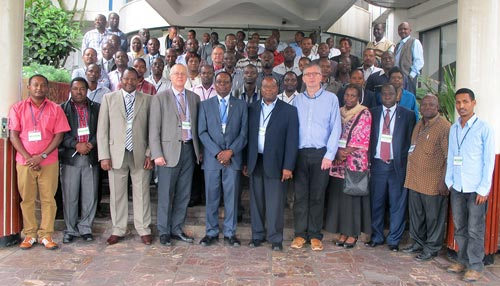By Wandera Ojanji/CIMMYT
The Insect Resistant Maize for Africa (IRMA) project received praise for significant progress on field and post-harvest insect pest research at its conclusion last month.
“Several new maize hybrids and open pollinated varieties with substantial insect resistance have been produced that will greatly benefit maize growers in eastern and southern Africa,” said Mike Robinson, program officer for the Syngenta Foundation for Sustainable Agriculture (SFSA) at the IRMA End-of-Project Conference in Nairobi, Kenya, from 24-26 February. Robinson congratulated CIMMYT and project partners and wished the participating organizations continued success. The purpose of the conference was to share experiences, achievements and lessons from IRMA III and discuss future prospects in the release, dissemination and use of insect-resistant maize in eastern and southern Africa.
It drew more than 80 participants from CIMMYT, national agricultural research systems, national universities, donors and the seed industry. The Developing Maize Resistant to Stem Borer and Storage Insect Pests for Eastern and Southern Africa project, known as IRMA III Conventional Project 2009-2013, was managed by CIMMYT and funded by SFSA. Building on progress and breakthroughs of IRMA I and II, IRMA III contributed to food security by developing and availing field and post-harvest insect-resistant maize varieties in Ethiopia, Kenya, Malawi, Mozambique, Tanzania, Uganda, Zambia and Zimbabwe.

Collectively, these countries produce about 26 million tons and consume 32 million tons of maize annually. Relatively low maize productivity in the countries – about 1.3 tons per hectare (t/ha) compared to 4.9 t/ha worldwide – can be attributed in part to stem borers, according to Stephen Mugo, CIMMYT principal scientist and IRMA project leader. Stem borers destroy as much as 15 percent of maize crops, while maize weevils and the larger grain borer destroy 20 to 30 percent of harvested maize. Hugo De Groote, CIMMYT economist, estimated the losses from stem borers at 13.5 percent, or 4 million tons, and those from storage pests at 11.2 percent, or 3.5 million tons, with the total value of these losses estimated at just over US$1 billion in the region. “Addressing the challenges that farmers face in producing and storing maize is vital to the future food security of the region,” Robinson said. “Minimizing such losses in an economically sustainable way will significantly contribute to nutrition and food security.”
IRMA III addressed these challenges through identification and commercial release of major insect-resistant maize cultivars; identification of new germplasm sources of resistance to stem borer and post-harvest insect pests among landraces, open pollinated varieties (OPVs) and CIMMYT lines (CMLs); and development of new insect-resistant germplasm. Kenya released 13 stem borer-resistant (SBR) conventional maize varieties (three OPVs and 10 hybrids) and four storage pest-resistant (SPR) hybrids. Kenya has also nominated nearly 10 stem borer- and four postharvest- resistant hybrids to national performance trials.
Three insect-resistant varieties —two hybrids (KH 414-1 SBR and KH 414-4 SBR) and one OPV (Pamuka) – were commercialized in Kenya by Monsanto, Wakala Seeds and the Kenya Agricultural Research Institute Seed Unit. De Groote estimated the annual value of project benefits at between US$ 19 million and US$ 388 million. He put the benefit-cost ratio at 94 in the optimistic scenario, meaning that for each dollar the project spent, farmers would gain 95, indicating very good returns.
“These results justify the important role that breeding for resistance could play in reducing maize losses, and the high potential returns to such programs in the future,” De Groote stated. Looking to the future, Mugo emphasized the need to ensure farmers have access to the insect-resistant varieties. “We must, from now on, engage in variety dissemination and commercialization of the new SBR and SPR varieties,” Mugo said. “We need a more targeted breeding program that incorporates drought, nitrogen use efficiency and maize lethal necrotic disease tolerance.”
 Climate adaptation and mitigation
Climate adaptation and mitigation